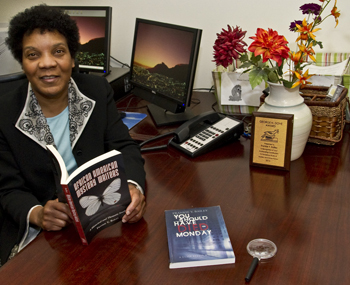Frankie Bailey Explores Clothing and Crime
 |
Award-winning criminologist and mystery writer Frankie Y. Bailey looks for clues. (Photo Mark Schmidt) |
When two men desired former Gibson Girl model Evelyn Nesbit Thaw, one of them died violently. Evelyn's millionaire husband Harry Thaw shot architect Stanford White in the rooftop theatre of Madison Square Garden in front of a room full of people.
Thaw was wearing evening clothes when taken into custody after killing White. While that might seem like a minor detail to some, to School of Criminal Justice Associate Professor Frankie Y. Bailey, it is a clue. The author of four mystery novels and several scholarly non-fiction books on crime and popular culture, Bailey has a new research area: clothing and crime.
She is writing a book with the working title: Strip Search: Crime, Justice, and Clothing in American Culture. The UAlbany criminologist and mystery writer recently took part in a panel on fashion in the 1920s and 1930s at the annual meeting of the Popular Culture Association/American Culture Association in St. Louis, Mo., where she was honored with the George N. Dove award for making a major contribution to the serious study of crime fiction.
In her paper she discussed several sensational crimes of the early 20th century � like the Stanford White murder - as examples of the role of clothing and style in criminal cases. Although the glamorous Mrs. Thaw dressed modestly as her husband awaited trial, she was a former chorus girl as well as model. On her way to the trial one day, she was mobbed and women "ripped at her brown coat." Examining turn-of-the-century murders gave Bailey "an opportunity to think systematically about dress and clothing in high-profile cases." Clothing appears in the narrative as not only evidence of a crime, "but an indication of status, character, and state of mind."
Another case Bailey examined was the 1927 Ruth Snyder-Judd Gray "Double Indemnity" case. Nicknamed "The Bloody Blonde" and "The Granite Lady," Ruth Snyder was judged harshly not only because of her part in her husband's murder, but because of her flapper-style New Woman looks and clothing.
 |
Criminologist and mystery writer Frankie Bailey with two of the books that were referenced in her selection as a Dove award winner. (Photo Mark Schmidt) |
"I don't have to tell you that clothing is a form of communication," said Bailey. "In the area of criminal justice, communication � what one seems to be communicating and how it is interpreted � can be literally a matter of life or death. Wear the wrong color in gang territory and you could end up dead."
There are few studies on the impact of attractiveness on perception of criminality, said Bailey. Still, lawyers may take their clients shopping to "clean them up" for trial. A poor defendant is likely to be dressed in prison garb for the perp walk; middle- and upper-class male defendants generally appear for their trial in a suit and tie.
In 2008, Bailey's book African American Mystery Writers: A Historical and Thematic Study (McFarland, 2008) provided a study of African American crime writers within the social and historical contexts of the U.S. justice system. Most recently, she co-wrote Wicked Albany (History Press, 2009), the story of Albany, N.Y. during Prohibition.
Her four mystery novels, published by Overmountain Press, are: Death's Favorite Child (2000), A Dead Man's Honor (2001), Old Murders (2003), and You Should Have Died on Monday (2007). A forthcoming novel is titled 40 Acres and a Soggy Grave. They feature Lizzie Stuart, a UAlbany graduate.
![]() For more news, subscribe to UAlbany's RSS headline feeds
For more news, subscribe to UAlbany's RSS headline feeds


